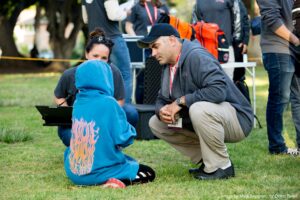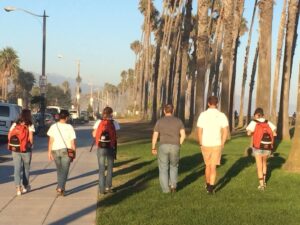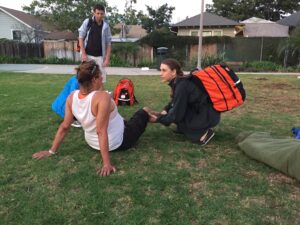BY SAM WATERSTONE | June 29, 2020
According to the 2020 Point in Time Count for Santa Barbara County, 613 people were experiencing chronic homelessness as of January 2020, a 45 percent surge from 2019. Since then, the economic fallout from the COVID-19 pandemic has certainly caused this number to increase further, and service providers throughout the Central Coast are only beginning to determine the extent of this housing crisis. Fortunately, our social sector has been gathering information and forming partnerships to develop a stronger safety net for our unsheltered neighbors.

Since 2005, Doctors Without Walls – Santa Barbara Street Medicine (DWW) has been one of the key groups leading the effort to strengthen this safety net. DWW is a volunteer-run nonprofit that provides free medical care to many of Santa Barbara’s unsheltered residents, while working with volunteer medical professionals and partner organizations to ramp up our county’s emergency response capabilities. Given the nature of their work, DWW has played a critical role in responding to the current public health emergency impacting our homeless community.
When Governor Newsom issued his stay at home mandate in mid-March, along with guidelines that severely limited gatherings, Doctor Without Walls immediately discontinued their “place-based clinics.” These were weekly pop-up health clinics that took place in parks and other central locations in Santa Barbara, Goleta, and Lompoc, where many unsheltered individuals gathered to access medical care and other essential services.
Per the 2020 Point in Time Count, more than 1,500 unsheltered individuals reside in Mid County and South County combined (the areas where DWW operates), and a significant portion of this population often rely on congregate housing (i. e. homeless shelters) to provide shelter and safety.
The governor’s mandate stated that unsheltered populations in California were not to be placed in congregate housing, and must instead be placed in non-congregate housing (i.e. hotel rooms) as part of the statewide program known as Project Roomkey. However, the only people allowed into the program were those age 65 or older, and individuals with underlying medical conditions.
“For Santa Barbara, it basically meant that most of our unsheltered population would need to shelter outside,” said Maggie Sanchez, co-founder and volunteer leader at DWW. “Because of social distancing, our homeless shelters – such as PATH and Rescue Mission – had to greatly reduce the amount of clients they could serve, so that meant a multitude of people back out on the street and sheltering in place.”
With their place-based clinics suspended and a severe need for additional medical support for unsheltered community members, DWW decided to increase their medical street missions.

“We’re a backpack-based medical organization. We have clinician-led teams that include a doctor, two pre-med students (one who is a scribe and another who shoulders the packs and helps distribute medical equipment), and also a peacekeeper, because we’re never quite sure what we’re going to encounter when we’re out there,” explained Sanchez. “We became a sort of primary care for this population, and have increased our street missions to support the need.”
Both on-foot and medical van outreach services were expanded in order to provide care and information to unsheltered people located in the less accessible, outlying areas of town. Many unsheltered residents are no longer able to access the social services they normally rely on, so these street missions have been a lifeline for some of the most vulnerable in our community.
Recently, one of the mobile street teams found and rescued a women who was sick, laying incapacitated in the dunes near East Beach, across from Chase Palm Park. The team likely saved her life.
“I don’t know how they found her, but they did,” recalled Sanchez. “She had active MRSA – her whole arm was infected – and so we were able to clean up her wounds, give her antibiotics, and refer her back for check-ups. That is why our on-foot street teams are out there.”
As outreach efforts increased, DWW volunteers noticed that many of their unsheltered clients were experiencing intensified food insecurity. Hunger is a major threat to public health, so DWW decided to investigate the issue.
“We do medicine really well, but we didn’t know much about distributing food. So we started looking into food distribution and the agencies working in that space, and why that food wasn’t trickling down to this particular population,” Sanchez said.
What DWW discovered was that prior to COVID-19, the populations they served were receiving much of their food from faith-based meal shares and leftovers from local restaurants, or subsisted on panhandling. But with those typical food sources limited or shut down completely, it became clear that our nonprofit community needed to rally together to feed individuals who weren’t being reached by existing programs. Recognizing this need, DWW joined with community partners to work on a solution.

“In a collaboration with Showers of Blessing, who donated a Ford van to DWW for our short-term use, we have now converted that van into a mobile food pantry. That food pantry is filled with bags of healthy, organic, non-perishable food items that provide 2-3 days of nourishment in between warm meals,” described Sanchez.
“We’re hoping that this takes the edge off the hunger until our community is able to resume normal services going forward. Lots of partners came in on this – SB ACT, B’nai B’rith, Oceanhills, and many others. If there is a silver lining, it is that a light is shining on an area that has needed support for so long, and right now we’re feeling extremely supported.”
Additionally, Doctors Without Walls has distributed several hundred solar chargers to encampments to help clients keep their cell phones charged, allowing them to communicate with DWW when someone is sick or when information is needed. DWW recently initiated telemedicine, led by a cadre of nurses and a physician who is on call, and the unsheltered population has been very receptive to the program thus far.
While crisis response efforts have been a stressful endeavor for everyone involved, this is exactly the type of situation that DWW was designed to handle.
“We’re kind of in our comfort zone here,” expressed Sanchez. “We’ve been dealing with transitory populations for a long time. We listen to the homeless taskforce phone calls and hear what our partners see out in the community, and together we respond. We know that together we can make a difference.”
The Santa Barbara Foundation has been a proud partner of Doctors Without Walls since the organization was founded in 2005, understanding that even though our county has a strong public health system and incredible homeless service providers, our unsheltered neighbors need additional support.
“The Santa Barbara Foundation gave us our first $25,000, our first seed money,” Sanchez remembered. “They brought us to the table with people from the Foodbank of Santa Barbara County, from Hospice of Santa Barbara, from Pacific Pride Foundation, and for the first time ever, I sat in the room with all the big guys and listened to how they became successful. And they’ve been there for us ever since.”
For more information about Doctors Without Walls and to learn how to get involved, visit sbdww.org or follow @DoctorsWithoutWalls.